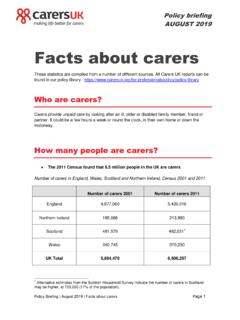Transcription of Epilepsy prevalence, incidence and other statistics
1 Epilepsy prevalence , incidence and other statistics Joint Epilepsy Council of the UK and Ireland The Joint Epilepsy Council is the umbrella charity providing the representative voice working for the benefit of people affected by Epilepsy . September 2011. Introduction The Joint Epilepsy Council (JEC) first produced nationally recognised incidence and prevalence figures in 2005. These figures have been reviewed and updated and show a large rise in the number of people with a diagnosis of Epilepsy and a prescription for anti-epileptic drugs. It is suggested that this rise is due to a combination of four reasons: Greater attention to recording and monitoring people with Epilepsy due to initiatives such as the GP Quality and Outcomes Framework. The introduction and implementation of the NICE and SIGN clinical guidelines. The ageing population and the higher incidence of Epilepsy in later life.
2 The general population increase. It is acknowledged that an exact figure for the number of people with Epilepsy is difficult to produce due to complicating factors such as misdiagnosis rates, inconsistent reporting, variations in the definition for active Epilepsy and anti-epileptic drugs (AEDs) being prescribed for other conditions. A variety of sources were reviewed in the production of these data including, in particular, the General Practice Research Database (GPRD) Data sets, Quality and Outcomes Framework prevalence data and NHS Information Centre for Health and Social Care and the IMS Health Disease Analyzer. The prevalence and incidence figures used in this report are based on an analysis of GPRD. data commissioned by the Joint Epilepsy Council applied to the Office of National statistics (ONS) mid-year population estimates 20101 (see methodology). The prevalence figures are based on patients with a diagnosis of Epilepsy along with a current prescription of AEDs.
3 incidence figures are based on a new diagnosis of Epilepsy and a new prescription for AEDs. The numbers do not therefore include patients with Epilepsy who are not receiving AED. treatment, for whatever reason. In addition, although we recognise the high rate of misdiagnosing of other conditions as Epilepsy , these data have not been validated for the accuracy of the diagnosis. The data may therefore include a significant number of people (20- 30%) who have been given a diagnosis of Epilepsy and a prescription for AEDs but do not in fact have Epilepsy . Nevertheless these data are important and useful despite these limitations; health services social services and education organisations have to design and provide support services for people with Epilepsy based on the population with that diagnosis undergoing treatment. The Joint Epilepsy Council believes that the figure of approximately 600,000 people in the UK with a diagnosis of Epilepsy and receiving AED treatment is the best and most accurate estimate currently available.
4 These data are intended to provide an open and consistent approach to Epilepsy statistics and members are encouraged to use the information within their own work. Joint Epilepsy Council, September 2011 1. The epilepsies Epilepsy is a tendency to have recurrent seizures. It can affect anyone, at any age, from any walk of life. It is one of the most common serious neurological conditions. Epilepsy is not a single condition. There are over 40 different types of Epilepsy consisting of at least 29 syndromes and a further 12 or so clinically distinct groups defined by the specific cause or underlying There are at least 40 different seizure types and perhaps as many as 50 and individuals may have one or several different seizure Approximately 60% of people have tonic clonic seizures, 20% complex partial, 12% mixed tonic clonic and partial, 3% simple partial and less than 5% absence seizures, myoclonic seizures and other Around 3% of people with Epilepsy are photosensitive and have seizures induced by photic prevalence prevalence is a measure that allows us to determine a person's likelihood of having a disease or condition.
5 Therefore, the number of prevalent cases is the total number of cases of disease or condition existing in a population at any given time. A prevalence rate is the total number of cases of a disease existing in a population divided by the total population. Approximately 600,000 people in the UK have a diagnosis of Epilepsy and take anti-epileptic drugs. This is equivalent to approximately 1 in 103 people. The prevalence rate of Epilepsy in the UK is approximately per 1,000 or Based on 2010 population estimates the prevalence in each country is as follows (to the nearest 1,000): Country Population, Number of prevalence prevalence 2010 census people with rate, % rate estimate Epilepsy England 52,234,000 496,000 1 in 105. Wales 3,006,000 32,000 1 in 94. Scotland 5,222,000 54,000 1 in 97. Northern Ireland 1,800,000 20,000 1 in 90. United Kingdom 62,262,000 602,000 1 in 103. (Note due to rounding slight apparent inconsistencies may result).
6 Joint Epilepsy Council, September 2011 2. prevalence by different sections of the community in the UK. See Appendix 1 for a chart of prevalence by age group. Children aged 4 years and under with Epilepsy , the total number of is approximately 7,600 or 1 in 509. Children aged 16 years and under with Epilepsy , the total number of is approximately 51,500 or 1 in 240. Children and young people aged 18 years and under with Epilepsy , the total number is approximately 63,400 or 1 in 220. People 25 years of age and under with Epilepsy , the total is approximately 112,700 or 1 in 177. People aged 65 and over with Epilepsy , the total is approximately 154,000 or 1 in 67. Women of childbearing age (12 50) with Epilepsy , the total is approximately 139,000. As a proportion of the total population of people with Epilepsy this equals 23 per cent. People with learning or intellectual disability: More than one in five people with Epilepsy have learning or intellectual disabilities.
7 6. Social deprivation Epilepsy prevalence is 25 per cent higher in the most socially deprived areas compared to the least socially deprived World wide Epilepsy affects around 50 million people worldwide; 80 per cent of them are in developing countries. In these countries, although most cases can be treated, around 75% of people with Epilepsy are not receiving appropriate Joint Epilepsy Council, September 2011 3. incidence incidence is a measure of disease or condition that allows us to determine a person's probability of being diagnosed with a disease during a given period of time. Therefore, incidence is the rate of newly diagnosed cases of a condition. An incidence rate is the number of new cases of a disease divided by the number of persons at risk of the disease in a set time period. The following have been calculated based on figures from the GPRD applied to the 2010. population estimates.
8 In the UK the incidence is approximately: 51 per 100,000 per year or cases per 1,000 of population per year. Equivalent to approximately 32,000 new cases diagnosed per year (based on 2010 population estimates). Equivalent to approximately 87 new cases each day of the year. incidence by age The incidence of Epilepsy varies significantly by age. See appendix 2 for a graph of incidence by age. Joint Epilepsy Council, September 2011 4. Misdiagnosis Misdiagnosis rates in the United Kingdom, where a diagnosis of Epilepsy is incorrectly made, are between 20 31 Using an assumed rate of 23 per cent this equates to 138,000 people with a diagnosis of Epilepsy and receiving AEDs who do not have the condition. Up to 40% of children referred to a tertiary clinic do not have This does not include those with Epilepsy who have been misdiagnosed as having a different condition for which figures are unavailable.
9 Cost of misdiagnosis These figures are based on those in the Clinical Guidelines and Evidence Review for the Epilepsies: the evidence base for the NICE Epilepsy Clinical The medical costs have been updated for hospital and community health service (HCHS) The non- medical costs have been increased by Non- Population - People with Misdiagnosed, Medical medical, Country 2010 Epilepsy 23% Cost, 334 1,602 Total England 52,234,000 496,000 114,100 38,109,000 182,788,200 220,897,200. Wales 3,006,000 32,000 7,400 2,472,000 11,854,800 14,326,800. Scotland 5,222,000 54,000 12,400 4,142,000 19,864,800 24,006,800. Northern Ireland 1,800,000 20,000 4,600 1,536,000 7,369,200 8,905,200. United Kingdom 62,262,000 602,000 138,500 46,259,000 221,877,000 268,136,000. Joint Epilepsy Council, September 2011 5. Treatment gap In the UK, 70% of the population with Epilepsy could be seizure free with optimal Currently only 52% of the population of people with Epilepsy are seizure This 18% treatment gap equates to 108,000 people with Epilepsy having seizures when with optimal treatment they could be seizure free.
10 Too few children are offered, or referred early enough for, the surgery which could cure their Epilepsy or reduce their seizures. In 2008 only 108 operations were carried out compared to the estimate that 400 were It is considered that there is a backlog of as many as 2,300 children who could benefit from Too few adults are offered, or referred early enough for, the neurosurgery which could cure their Epilepsy or greatly reduce their seizures. It is estimated that no more than 200. - 300 individuals are treated each year in the UK compared to an estimate of at least 1,000 that are It is considered that there is a backlog of at least 5,000 adults who could benefit from Epilepsy related deaths In the UK 1,150 people died of Epilepsy related causes in 200917, 644 males and 506. females. In England and Wales 110 or 11% of those deaths are young adults or children under the age of Approximately 42% or 480 of the deaths per year are probably or potentially Sudden unexpected death in Epilepsy (SUDEP) is defined as the sudden, unexpected, witnessed or unwitnessed, non-traumatic and non-drowning death in patients with Epilepsy , with or without evidence for a seizure, with exclusion of documented status epilepticus, and when post-mortem examination does not reveal a structural or toxicological cause for SUDEP accounts for approximately half of all Epilepsy related deaths.




